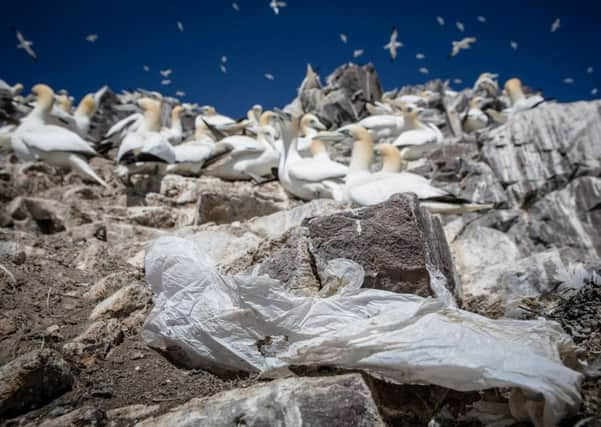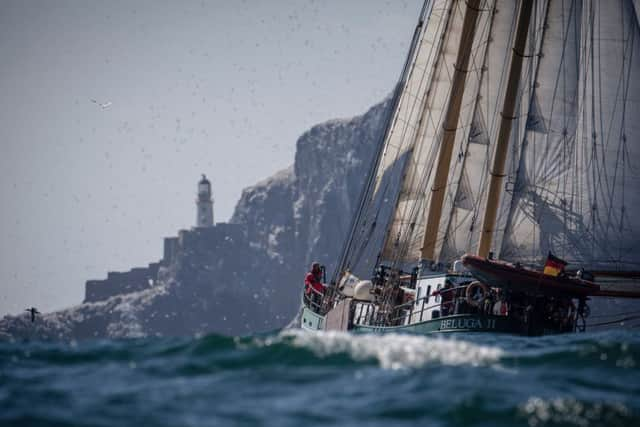Bass Rock birds choking on '˜plastic bags and crisp packets'


The findings have emerged after tests taken on the first day of a two-month scientific research voyage that aims to assess the impact of plastic pollution on Scotland’s internationally important marine wildlife.
More than 150,000 gannets make their homes on the Bass Rock, alongside puffins, guillemots, razorbills, shags, fulmars and kittiwakes.
Advertisement
Hide AdAdvertisement
Hide AdThe area also supports the biggest puffin colony on the east coast of the UK.


But pictures taken on the landmark Forth island reveal plastic rubbish strewn across the ground, around nests and even in the beaks of seabirds.
Scientists and environmentalists from Greenpeace set sail from Leith this week to begin surveys of seawater, shorelines and bird nesting sites. The crew, accompanied by experts from the Scottish Seabird Centre at North Berwick, landed at the Bass Rock to investigate nests and surrounding areas for plastic debris.
Early indications from sea-surface samples taken around the island suggest the waters contain microplastics.
Advertisement
Hide AdAdvertisement
Hide AdFurther analysis will be carried out on board the vessel and at Greenpeace’s research laboratories to confirm the extent of the contamination.


The researchers have expressed dismay at the extent of man-made pollution affecting wildlife in the Forth.
“Being surrounded by tens of thousands of gannets on the Bass Rock is a stunning spectacle, but it’s seabirds like these which are acutely threatened by ocean plastic pollution,” said Willie Mackenzie, oceans expert at Greenpeace UK.
“We found plastic bags, packaging, bits of old fishing gear and even crisp packets strewn across the island and surrounding eggs in nests.”
Advertisement
Hide AdAdvertisement
Hide AdTom Brock, chief executive of the Scottish Seabird Centre in North Berwick, highlighted the importance of the research and welcomed the opportunity to work with the Greenpeace team.
“Scotland’s amazing marine wildlife is of international importance. However, it is now facing a wide range of significant threats, including plastic pollution,” he said.
“Research and the raising of public awareness are vital to ensuring that our wonderful wildlife can be appreciated and enjoyed by future generations.”
The team will continue sampling as they sail up the coast to Inverness, then cut through the Caledonian canal and Loch Ness to reach the west.
Advertisement
Hide AdAdvertisement
Hide AdTests will be carried out over the course of the voyage, which takes in basking shark hotspots around Oban, Iona and Mull.
Divers will also be analysing the waters around the islands of Eigg, Rum and Skye, which are important for wildlife including dolphins, whales, diving birds and seahorses.
The team will then move on to the Outer Hebrides, visiting Uist and the remote Shiant Isles – a mecca for seabirds that is second only to neighbouring St Kilda for numbers of puffins and razorbills.
Global populations of seabirds have declined by almost 70 per cent in the past 60 years, with plastic pollution – along with the impacts of climate change and overfishing – believed to be a contributory factor.
Advertisement
Hide AdAdvertisement
Hide AdPrevious studies have suggested that 90 per cent of seabirds have ingested plastic, which can cause feeding problems and eventual death.
Entanglement in plastic litter is also a problem, and similarly can prove fatal.
United Nations figures suggest ocean plastic kills hundreds of thousands of marine animals each year, including turtles and dolphins.
A dying whale that washed up in Norway recently was found with a stomach full of plastic, causing it to starve to death.
Advertisement
Hide AdAdvertisement
Hide AdCampaigners are calling for urgent action to stem the flow of plastic into the marine environment.
“A truckload of plastic enters the ocean every minute, and 16 million plastic bottles end up in our environment every day in the UK,” Mr Mackenzie added.